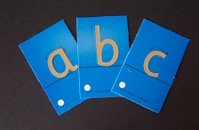Our four year old has been product testing the My First Wipe Clean a-z letters over the half term holiday and has thoroughly enjoyed himself (and yes he is appearing to be left handed).

News from Littlesheep Learning and the wider world of education and learning.

With the advent of computers into family life it is sometimes easier to get our eldest to type his messages as until recently writing was not something that he enjoyed. Typing a letter onto a computer is less personal if it is just the name and present details that are changed and it doesn't show the child's developing handwriting (although we did leave in the creative spellings!) but it does get the job done.
Having done our letters and felt proud that they are all in envelopes ready to post I then stumbled across this link on Filth Wizardry about a website where you can generate a font of your child's handwriting. You download a printable template for your child to write each letter of the alphabet (plus the common punctuation marks), scan it in and upload the image and wait for your font which you can then use in all of your documents. As I said - we haven't tried it yet but there are some great examples on the Filth Wizardry post so you can see how it works. I think we will try this for the birthday thank you letters later in the year - so watch this space!
 Littlesheep Learning has just taken delivery of some new slim triangular pencils alongside our popular jumbo triangular pencils. We started stocking the jumbo triangular pencils as a replacement for the Berol Handhugger Pencils which unfortunately have been discontinued by the manufacturer and are pleased that they have been as popular among our customers.
Littlesheep Learning has just taken delivery of some new slim triangular pencils alongside our popular jumbo triangular pencils. We started stocking the jumbo triangular pencils as a replacement for the Berol Handhugger Pencils which unfortunately have been discontinued by the manufacturer and are pleased that they have been as popular among our customers.  Write the letter for your child and get them to decorate it by sprinkling glitter, sticking on Christmassy stickers and doodling borders, they could also add their own name.
Write the letter for your child and get them to decorate it by sprinkling glitter, sticking on Christmassy stickers and doodling borders, they could also add their own name. We are pleased to announce that we are now stocking the Write from the Start handwriting programme. This writing programme is based on holistic principles and offers a different approach to learning to write, by developing the muscles of the hand - so that children gain the necessary control to produce letter forms - alongside the perceptual skills required to orientate and organize letter and words.
We are pleased to announce that we are now stocking the Write from the Start handwriting programme. This writing programme is based on holistic principles and offers a different approach to learning to write, by developing the muscles of the hand - so that children gain the necessary control to produce letter forms - alongside the perceptual skills required to orientate and organize letter and words.So here are some of my favourite ways to get children practicing writing / drawing skills without using a pencil and paper!
Let me know any other fun ways you persuade your children to write!
 One of the simplest aids are triangular pens and pencils, for example, the Handhugger Pencil. These triangular HB pencils are popular in schools and nurseries and have a strong lead for younger writers. They are ideal for all early writing and drawing activities because the chunky triangular shape enables children to hold the pencil easily. Handhugger pencil's are also great for those with fine motor difficulties and helping children to use the correct grip.
One of the simplest aids are triangular pens and pencils, for example, the Handhugger Pencil. These triangular HB pencils are popular in schools and nurseries and have a strong lead for younger writers. They are ideal for all early writing and drawing activities because the chunky triangular shape enables children to hold the pencil easily. Handhugger pencil's are also great for those with fine motor difficulties and helping children to use the correct grip.  Different people find different aids best for them. Some people prefer a triangular pencil and other prefer on of the pencil grips, to help you select the type of grip most suited to you or your child at Littlesheep Learning we sell a special value Triangular Writing Set. The Triangular Writing Set includes: 1 Triangular Pencil Grip, 1 Grippy Pencil Grip, 1 Tri-Go Pencil Grip and 1 Handhugger Pencil.
Different people find different aids best for them. Some people prefer a triangular pencil and other prefer on of the pencil grips, to help you select the type of grip most suited to you or your child at Littlesheep Learning we sell a special value Triangular Writing Set. The Triangular Writing Set includes: 1 Triangular Pencil Grip, 1 Grippy Pencil Grip, 1 Tri-Go Pencil Grip and 1 Handhugger Pencil. 
For letter formation teaching aids check out the Rol 'n' Write alphabet and sandpaper letters at Littlesheep Learning.

